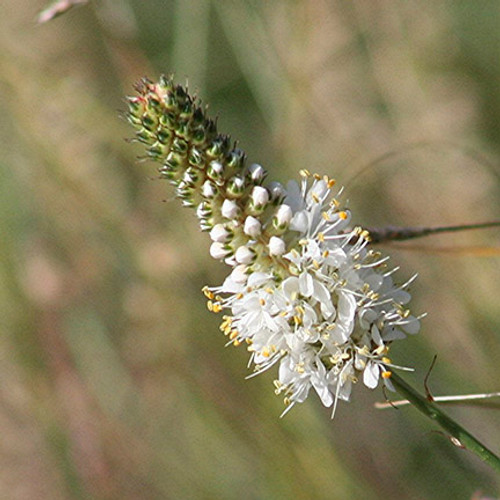Violet prairie clover is a native, warm-season legume which grows to a height of 30 to 90 cm. Several stems may grow from a single base. The flowers are pinkish-purple on elongated spikes which are 2-4 cm long. The flower head at the end of a wiry stem is cylindrical, with a fringe of rosy petals on a partly bare cone. Violet prairie clover flowers the last of May through September. The leaves are divided into 3-5 narrow leaflets which may be sparingly hairy. Violet prairie clover can be used in roadside plantings, as wildlife food and habitat, in wildflower gardens because of its attractive flowers, and as a small component in a seeding mixture for prairie restoration. Tea can be made from vigorous taproot to reduce fever in measles victims. This plant is highly palatable and nutritious. It is grazed often and tends to decrease under heavy use. Violet prairie clover fixes nitrogen in the soil.
Adaptation and Distribution
Violet prairie clover occurs in prairies, rocky open glades, along railroads, and rocky or open woods. It ranges from Indiana to Saskatchewan and Montana, south to Tennessee, Arkansas, Texas and New Mexico; also in Alabama and introduced east to New York. It is most abundant in the upland of the true prairie. It also occurs in sand prairies, hill prairies, and gravel-hill prairies. For a current distribution map, please consult the Plant Profile page for this species on the PLANTS Website.
Establishment
Prepare a clean weed free seedbed by disking and harrowing. Firm the seedbed by cultipacking. The seedbed should be firm enough to allow the seed to be planted ¼ inch deep. A seeder with a legume box works well in the seeding operation, although other types of seeders or drills may be used. Violet prairie clover is easily propagated from seed. Seed sown in spring will produce transplants in one season. For permanent plantings, sow unstratified inoculated (Inoculum –F) seed in fall, stratified inoculated seed in spring. Plants are largely cross-pollinated. Violet prairie clover grows well on well-drained or dry soils. ©W.L. Wagner Smithsonian Institution @USDA NRCS PLANTS Seeding rates for violet prairie clover should be about two pounds of pure live seed (PLS) per acre for seed production in 36-inch rows. For solid stand production, drill three times the seeding rate of row production to maintain 40 PLS per square foot. For prairie restoration or diverse plantings for wildlife, use at least five species of native grasses and ten species of native forbs or legumes. Plant purple prairie clover at a rate of eight ounces/acre PLS when this species is 0-5% of the combined mixture. Scarified inoculated seed should be used in spring plantings and unscarified inoculated seed should be used to make fall plantings. There are approximately 300,000 clean seeds in one pound of violet prairie clover. Apply no fertilizer the establishment year unless a soil test indicates a severe deficiency of potassium and/or phosphorus. Use no nitrogen during the establishment year as this can encourage weed competition.
Management
Reduce weed competition by mowing at a height that will not affect the purple prairie clover seedlings. For grassy weed control use Poast herbicide and follow label recommendations, as herbicide weed control will encourage a good stand. For preemergence or post emergence, Plateau herbicide is labeled; follow label recommendations.










